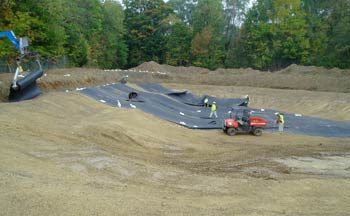 |
The firm designed a passive wetland system as a long-term solution to treat 280,000 gallons per day of contaminated groundwater in Wellsville, N.Y. As part of that project, the crew places an impermeable liner in the wetland basin. The system consists of a cascade aerator, sedimentation pond, parallel surface flow wetlands, parallel vertical flow limestone drains, and sand drying beds for iron precipitate dewatering. |
Exploiting the biological complexity of natural systems to cope with the complexity of industrial waste streams is becoming a more attractive option because engineered treatment wetlands typically are mechanically simple and have low operation and maintenance costs.
While many industrial companies spend a great deal of money treating wastewater to comply with environmental regulations, they are now also considering the additional benefits and perceived value of treating industrial wastewater using engineered wetlands. When integrated with nature centers, trail networks, and natural habitats, industrial treatment wetlands become valued as responsible solutions that are environmental showcases for a company.
Making natural wetlands work in industrial applications depends on disciplined engineering practices. Taking away the geometric uncertainty is first, closely followed by installation of impermeable liners, and specific placement of influent and effluent points. With the additional control of water level, the systems begin to behave more like an engineered reactor.
A wetland cell can be rigorously engineered to be a stand-alone treatment process, or it can be coupled with other processes, such as lagoons, to augment performance. Loading rates are controlled to exploit bacterial growth. Wetland cells are filled with gravel media, which is cleaned and sized to optimize hydraulics and treatment. A blower supplying bed aeration is installed, which allows the engineer the freedom to control location and size of aerobic zones. Flow within the wetland is recirculated to optimize treatment. Mulch is used for insulation. Eventually, what seemed to be a passive, uncontrollable technology begins to have a process schematic similar to advanced sewage plants. Given such freedom of control, engineered wetlands can be "tailored" to live with and treat a wide spectrum of pollutants.
No comments:
Post a Comment